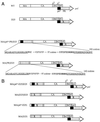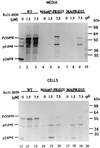Assembly and processing of human immunodeficiency virus Gag mutants containing a partial replacement of the matrix domain by the viral protease domain
- PMID: 10708461
- PMCID: PMC111845
- DOI: 10.1128/jvi.74.7.3418-3422.2000
Assembly and processing of human immunodeficiency virus Gag mutants containing a partial replacement of the matrix domain by the viral protease domain
Abstract
We constructed human immunodeficiency virus (HIV) mutants by replacing the matrix domain with sequences encoding the viral protease or p6* and protease. The chimeras retaining matrix myristylation and processing signals underwent efficient autoprocessing with severely defective particle budding. The budding defects of the chimeras were rescued by suppressing the chimera protease activity either through addition of an HIV protease inhibitor or through inactivating the chimera protease via a substitution mutation of the catalytic aspartic acid residue. This resulted in the release of chimeric virus-like particles with the density of a wild-type retrovirus particle. In addition, the assembly-competent but processing-defective chimeras produced proteolytically processed particles with significant reverse transcriptase activity when a downstream native pol gene was present. These results suggest that HIV has the potential to adapt heterologous sequences in place of the matrix sequence without major effects on virus-like particle budding. In addition, the positions of the protease and substrate accessibility may contribute significantly toward avoiding a premature Gag or Gag-Pol process, which leads to severe defects in both particle budding and incorporation.
Figures




Similar articles
-
Characterization of human immunodeficiency virus type 1 Pr160 gag-pol mutants with truncations downstream of the protease domain.Virology. 2004 Nov 10;329(1):180-8. doi: 10.1016/j.virol.2004.08.010. Virology. 2004. PMID: 15476885
-
The virus-associated human immunodeficiency virus type 1 Gag-Pol carrying an active protease domain in the matrix region is severely defective both in autoprocessing and in trans processing of gag particles.Virology. 2004 Jan 20;318(2):534-41. doi: 10.1016/j.virol.2003.08.043. Virology. 2004. PMID: 14972522
-
Efficient particle production by minimal Gag constructs which retain the carboxy-terminal domain of human immunodeficiency virus type 1 capsid-p2 and a late assembly domain.J Virol. 2000 Jun;74(12):5395-402. doi: 10.1128/jvi.74.12.5395-5402.2000. J Virol. 2000. PMID: 10823843 Free PMC article.
-
Natural variation in HIV-1 protease, Gag p7 and p6, and protease cleavage sites within gag/pol polyproteins: amino acid substitutions in the absence of protease inhibitors in mothers and children infected by human immunodeficiency virus type 1.Virology. 1996 May 15;219(2):407-16. doi: 10.1006/viro.1996.0266. Virology. 1996. PMID: 8638406
-
[What's going on post-budding?].Uirusu. 2011 Jun;61(1):91-8. doi: 10.2222/jsv.61.91. Uirusu. 2011. PMID: 21972560 Review. Japanese.
Cited by
-
Placement of leucine zipper motifs at the carboxyl terminus of HIV-1 protease significantly reduces virion production.PLoS One. 2012;7(3):e32845. doi: 10.1371/journal.pone.0032845. Epub 2012 Mar 1. PLoS One. 2012. PMID: 22396796 Free PMC article.
-
Gag-Pol Transframe Domain p6* Is Essential for HIV-1 Protease-Mediated Virus Maturation.PLoS One. 2015 Jun 1;10(6):e0127974. doi: 10.1371/journal.pone.0127974. eCollection 2015. PLoS One. 2015. PMID: 26030443 Free PMC article.
-
HIV-1 matrix domain removal ameliorates virus assembly and processing defects incurred by positive nucleocapsid charge elimination.FEBS Open Bio. 2015 Apr 9;5:283-91. doi: 10.1016/j.fob.2015.04.003. eCollection 2015. FEBS Open Bio. 2015. PMID: 25905033 Free PMC article.
-
HIV-1 matrix protein repositioning in nucleocapsid region fails to confer virus-like particle assembly.Virology. 2008 Aug 15;378(1):97-104. doi: 10.1016/j.virol.2008.05.010. Epub 2008 Jun 12. Virology. 2008. PMID: 18550141 Free PMC article.
-
HIV-1 Mutant Assembly, Processing and Infectivity Expresses Pol Independent of Gag.Viruses. 2020 Jan 2;12(1):54. doi: 10.3390/v12010054. Viruses. 2020. PMID: 31906562 Free PMC article.
References
-
- Chen Y-L, Ts'ai P-W, Yang C-C, Wang C-T. Generation of infectious virus particles by transient co-expression of human immunodeficiency virus type 1 gag mutants. J Gen Virol. 1997;78:2497–2501. - PubMed
-
- Freed E O. HIV Gag proteins: diverse functions in the virus life cycle. Virology. 1998;251:1–15. - PubMed
-
- Gelderblom H R. Assembly and morphology of HIV: potential effect of structure on viral function. AIDS. 1991;5:617–638. - PubMed
-
- Henderson L E, Bowers M A, Sowder II R C, Serabyn S A, Johnson D G, Bess J W, Jr, Arthur L O, Bryant D K, Fenselau C. Gag proteins of the highly replicative MN strain of human immunodeficiency virus type 1: posttranslational modifications, proteolytic processing, and complete amino acid sequences. J Virol. 1992;66:1856–1865. - PMC - PubMed
-
- Hunter E. Macromolecular interactions in the assembly of HIV and other retroviruses. Semin Virol. 1994;5:71–83.
Publication types
MeSH terms
Substances
LinkOut - more resources
Full Text Sources
Research Materials

